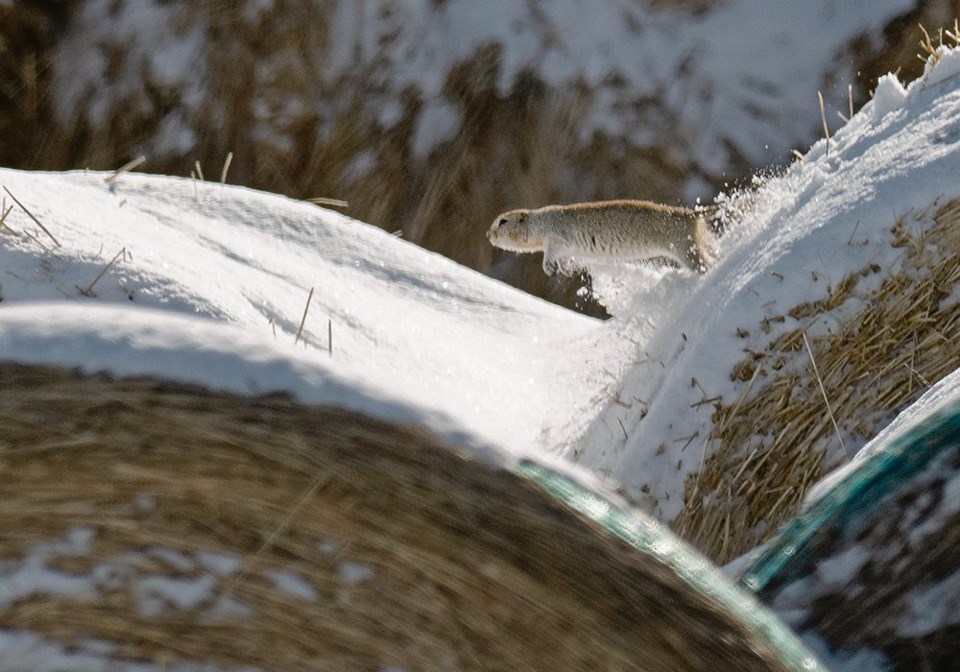WESTERN PRODUCER — March 4 was the last day municipalities and counties were allowed to sell two percent strychnine to farmers for Richardson’s ground squirrel control.
Next March 4 will be the last day farmers in Alberta and Saskatchewan will be allowed to use the product.
For producer David Dick, the loss of strychnine, the only effective gopher control, will have a massive impact on his central Alberta farm in Alberta’s Special Areas.
“If we don’t have strychnine to use the losses will be huge,” said Dick of Oyen.
Already gophers, the common name for Richardson’s ground squirrels, migrate from native and tame pastures into his crop land, chewing their way through acres of crop.
“Over the last few years, they’ve moved everywhere.”
Dick said the other products still available are not as effective and are a costly way to control the gopher population.
“The bottom line is we need strychnine.”
Saskatchewan Association of Rural Municipalities president Ray Orb said the loss of the product will be “detrimental to farmers.”
“What we are being told is farmers are going to have to buy alternative chemicals to control Richardson’s ground squirrels, but unfortunately there is nothing out there as effective. This is not the first time the federal government has taken it away, although at this time, it doesn’t look like we will get it back.”
From 1992 to 2001, strychnine was deregistered and the Richardson’s ground squirrel population increased, causing millions of dollars of losses in crops and pastures. The decision was reversed and the poison was allowed again to control gophers in Saskatchewan and Alberta.
Concern that non-target species were being killed in addition to gophers convinced Health Canada’s Pest Management Regulatory Agency in 2020 to announce it would be discontinued again.
Later that year, a delegation from SARM flew to Ottawa to make their case about the need to keep the product, but Orb said their arguments fell on deaf ears. Unlike in the 1990s when strychnine was discontinued and brought back, Orb isn’t confident Health Canada will reverse its decision this time.
“It is really upsetting to be honest with you.”
A resolution at the upcoming March SARM convention directs officials to continue to lobby for the reversal of the decision
“Our farmers don’t really think this battle is over. In our mind I think it is over,” said Orb of Cupar, Sask.
“They have really closed the door to us in Ottawa.”
Special Areas communication officer Maeghan Chostner said sales of strychnine at all their locations completely sold out by March 4 at noon, the last day of sales.
“There is a large demand by producers in the area for it. Our agricultural fieldmen work with ranchers and farmers to find solutions that work for them,” she said.
Karen Wickerson, rat and pest program specialist with Alberta Agriculture, has spent the winter delivering presentations on options for gopher control.
“I certainly have been receiving a lot of calls from the agricultural fieldmen out there about what to use in place of strychnine.”
Rozol, an anticoagulant, is still available, but takes several feedings before the gophers die.
“It is challenging for producers. I get it. They are getting prepared for seeding and a lot are calving, if they have cattle, and they don’t have enough time. It is challenging timewise to concentrate on controlling them.”
Another less known product, Ramik Green, is also available. Unlike strychnine and Rozol, which are placed on grain, Ramik Green comes in a pellet form and may be less desirable by the rodents, she said.
Without the use of strychnine for control, farmers will be forced to look at other ways to control gophers, she said.
“There are lots of non-chemical means of control. Raptor nesting platforms are a really good option in parts of the province where there are open areas and not a lot of trees.”
The platforms encourage raptors to nest in a particular area. One pair of nesting hawks can consume up to 500 ground squirrels in a season.
Despite what it seems, the mortality rate of Richardson’s ground squirrels is high, especially males at the beginning of the season. Many die from predation, starvation, bad weather and drowning as many are forced into unfavourable habitats by competing males.




